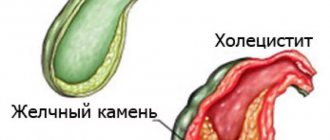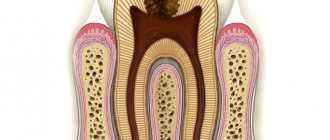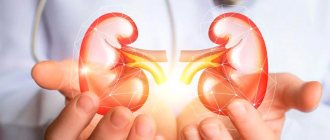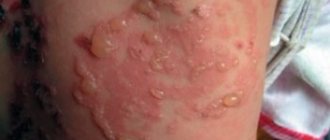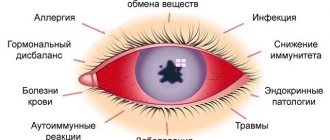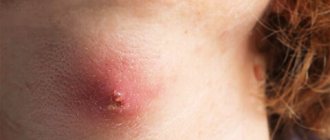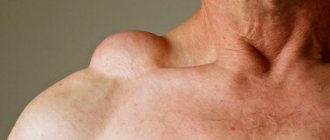Eczema and stages of its development
The term eczema comes from the Greek word ekzeo - to flare up, to boil. It was first mentioned in 541 in the scientific works of Aetius, a Byzantine physician. However, in those days, this term was used as a general collective name for dermatological diseases with acute development - erythema, urticaria, erysipelas, etc. It was only in the 18th century that eczema was identified by scientists as a separate, independent disease.
This is a pathology of allergic origin. It can be caused by various reasons, depending on its type. There are more than 20 types of eczema. All of them manifest themselves in a similar way, the differences are only in the cause of the disease and the duration of the rash.
Eczema has 4 stages of development:
- Erythematous - reddish-pink spots appear on the skin, which rapidly increase in number and size.
- Papular - small papules (nodules) appear, which are accompanied by swelling.
- Vesicular – vesicles (bubbles) are formed.
- Weeping - the vesicles open, and bright red erosions (wounds) appear, from which a clear serous fluid (exudate) is released.
Reference! With eczema, the general protective functions of the body are reduced.
This leads to both aggravation of atopic dermatitis and the development of other pathologies.
Bibliography
- Ayzyatulov R.F. Clinical dermatology. — Donetsk: Donetsk region. - 2002. - P. 9-11, 284-299.
- Zaslavsky D.V., Tulenkova E.S., Monakhov K.N., Kholodilova N.A., Kondratieva Yu.S., Tamrazova O.B., Nemchaninova O.B., Guliev M.O., Shlivko I L.L., Torshina I.E. Eczema: tactics for choosing external therapy. Bulletin of dermatology and venereology. 2018;94(3):56-66.
- Markova O.N. Microbial eczema: clinical picture, pathogenesis and principles of treatment//Military Med. magazine - 2004. - No. 7. - P.23-25.
- Margieva A.V., Khailov P.M., Krysanov I.S., Korsunskaya I.M., Avkentyeva M.V. /Pharmacoeconomic analysis of the use of methylprednisolone aceponate in the treatment of atopic dermatitis and eczema // A.V. Margieva., P.M. Khailov, I.S. Krysanov, I.M. Korsunskaya, M.V. Avkentieva. Medical technologies. Evaluation and selection. - No. 1, 2011. - P. 14-21.
- Studnitsyn Yu.K. Skripkin Yu.K. Classification of eczema // Vestn. dermatol. and venerol. - 1979.-No. 5. - P. 3-9.
- Khazizov I. E., Shaposhnikov O. K. On the mechanisms of inflammatory changes in the skin during eczema and eczema-like processes // Vestn. dermatol. and venerol.
- Barnes PJ Molecular mechanisms of corticosteroids in allergic diseases // Allergy. – 2001. – Vol. 56.– Supp. 10.– P. 928–936.
- Baumer JH. Atopic eczema in children, NICE // Arch Dis Child Educ Pract Ed. 2010 Dec; 95(12):1071 9. Chang C, Keen CL, Gershwin ME. Treatment of eczema. // Clin Rev Allergy Immunol. 2007 Dec;33(3):204-25.
- Drago L, Toscano M, Pigatto PD. Probiotics: immunomodulatory properties in allergy and eczema. //G Ital Dermatol Venereol. 2013 Oct;148(5):505-14.
- Halometasone 0.05% Cream in Eczematous Dermatoses // J Clin Aesthet Dermatol. 2013 Nov; 6(11): 39-44.
- De Waure C, Cadeddu C, Venditti A, Barcella A, Bigardi A, Masci S, Virno G, Cammisa A, Ricciardi W. Nonsteroid treatment for eczema: results from a controlled and randomized study. // G Ital Dermatol Venereol. 2013 Oct;148(5):471-7
- Zomer-Kooijker K, van der Ent CK, Ermers MJ, Rovers MM. Lack of Long Term Effects of High Dose Inhaled Beclomethasone for RSV Bronchiolitis - A Randomized Placebo-Controlled Trial // J Pediatr Infect DS.2013 Oct 28. 8.
Classification of eczema
According to the nature of the course, eczema can be:
- Spicy.
- Sub-acute.
- Chronic.
The acute form by the presence of rashes, exudate, redness and swelling of the skin. These symptoms are accompanied by severe itching and flaking of the skin. Then the exudate dries out, and crusts form on the pathological lesions. After this, epithelization (growth of new skin cells, formation of connective tissue) of the wounds occurs. In the subacute form, there are rashes, redness, peeling and itching, but there is no weeping (exudate). Chronic eczema is characterized by alternating periods of exacerbations and remissions. New weeping rashes are adjacent to dry crusts. Less exudate is released than in the acute form. In the chronic stage, there are more dry crusts on the body than weeping rashes, which is why this form is also called dry eczema. The crusts often crack, causing itching, which often causes patients to experience insomnia. Also in the chronic stage, severe peeling of the skin and the development of pigment spots may be observed. As a rule, exacerbations develop in the cold season, and remissions occur in the warm season.
Eczema is also classified according to the cause of its occurrence. As mentioned above, there are more than 20 types of this disease. The most common types of eczema are:
- Idiopathic (true).
- Microbial.
- Seborrheic.
- Professional.
- Children's room.
Idiopathic eczema develops due to a combination of several causes and can affect patients of any age. Usually the disease occurs abruptly and develops in spurts. Pathological foci, as a rule, have unclear boundaries, different sizes and are located symmetrically. The rashes alternate with areas of healthy skin. Most often, idiopathic eczema develops on the skin of the palms (on the back), feet and forearms. The acute form in most cases gradually turns into chronic.
Microbial eczema occurs when immunity decreases around chronic foci of infection: abrasions, wounds, fistulas, scratches, trophic ulcers. Pathological foci are located asymmetrically, clearly defined and covered with purulent crusts. This type of disease is characterized by the absence of areas of healthy skin between the rashes. Manifestations of eczema are usually observed on the skin of the arms and legs, but can also affect any part of the body, including the scalp.
Seborrheic eczema is a form of seborrhea (a disease that develops against the background of increased activity of the sebaceous glands). It appears as clearly defined red spots, which can have different shapes. The disease usually develops in people with increased sebum production and occurs in those areas where there are the most sebaceous glands: on the scalp and behind the ears, on the face, between the shoulder blades, in the nasolabial folds and on the chest. The causes of the disease are the activity of Malassezia fungi, hormonal disorders, and lack of vitamins. Emotional shocks are considered a provoking factor.
Occupational eczema is similar in clinical manifestations to idiopathic eczema. It develops due to regular contact with substances that cause allergic reactions (usually this occurs in industrial conditions). Occupational eczema goes away quite quickly if contact with the provoking substance is avoided. However, if the patient is not protected from its exposure, subsequent outbreaks of the disease will be more severe.
Infantile eczema is a type of idiopathic atopic dermatitis. In young patients, the disease proceeds a little differently than in adults: it is characterized by a variety of rashes and the release of a large amount of exudate.
Important! Eczema is not a contagious disease!
Pills
Antihistamines
Histamine is an important component in the development of eczema symptoms. This is a compound that is produced by immune cells and enters the tissue during inflammation and allergies. Histamine is responsible for many manifestations of the pathological process, but mainly irritates the receptors, which leads to severe itching. Antihistamines are designed specifically to relieve these symptoms. They block histamine receptors and prevent it from showing its effect. These medications cause drowsiness, and the newer ones exhibit this effect to a lesser extent, but they also relieve symptoms to a lesser extent.
| First generation | Second generation |
| Suprastin | Claritin |
| Diphenhydramine | Loratadine |
| Tavegil | Zyrtec |
| Diazolin | Fenistil |
Antibacterial
Infections sometimes complicate the course of the disease, especially if there is oozing and the integrity of the epithelium is compromised. Then drugs are needed to treat microbial processes, which are often prescribed for eczema on the legs, because this area is more prone to infection. If local therapy is not enough, antibiotic tablets are used. If we take into account the characteristics of the microbiome of the body, the most suitable are penicillins, cephalosporins and macrolides, which are also quite gentle on their own microflora. But only a doctor should prescribe them; self-medication in this case is dangerous.
Eczema: causes
Idiopathic eczema is a disease that develops due to a combination of reasons, the main ones of which are:
- Genetic predisposition – it has been proven that gene mutations that affect the development of the disease are inherited.
- Impaired epidermal barrier function.
- Immune system failures.
- Provoking factors.
Provoking factors include:
- General decrease in immunity.
- The presence of allergies in the patient or his close relatives.
- Hyperhidrosis (increased sweating).
- Use of products that irritate the skin (inappropriate cosmetics and perfumes).
- Endocrine disorders.
- Gastrointestinal diseases.
- Varicose veins.
- Stress.
- The presence of chronic foci of infection (for example, caries or chronic sore throat).
Reference! The presence of allergic rhinitis, bronchial asthma, and neurodermatitis in the mother increases the risk of eczema in the child by 40%. If similar diseases are observed in both parents, the risk increases to 60%.
Diagnosis of eczema
The disease has a characteristic clinical picture, so the diagnosis can be made based on examination of the patient and history taking. However, to identify the cause of eczema and develop an effective treatment plan, the following may be prescribed:
- General blood and urine tests.
- Determination of the level of immunoglobulin IgE in blood serum.
- Allergy and immunological tests.
- Bacteriological culture of the discharge (carried out when a secondary infection is attached and is necessary to determine the sensitivity of its pathogens to antibiotics).
- Biopsy.
Eczema: treatment
You cannot self-medicate for eczema: there is a risk of provoking the development of a secondary infection. In addition, the occurrence of pathology may be due to the presence of other diseases, so it is necessary to treat them. The patient may need the help of an immunologist, allergist, endocrinologist, nutritionist, phlebologist and other specialized specialists.
General therapy for eczema includes the following medications:
- Antipruritic.
- Anti-inflammatory.
- Antibacterial.
- Antifungal.
- External corticosteroids.
- Immunomodulators.
- Desinsibilizing and antihistamine.
- Antiseptic and astringent drugs.
- Vitamins (groups B, C).
In severe cases, physical therapy (exposure of affected areas to ultraviolet radiation) may be prescribed.
Treatment will be more effective if the patient follows a diet. First of all, any foods that can provoke an exacerbation of the disease are excluded from the diet: allergens, fried, spicy, fatty, canned, salty foods. It is necessary to eat light food rich in vitamins, minerals, essential fatty acids and protein: vegetables and fruits, herbs, cereals, boiled lean meat, dairy products, vegetable oils. It is also recommended to stop drinking alcohol and smoking during treatment.
Prevention of facial rashes
To prevent relapse of the disease, as well as in the case of a genetic predisposition (one or both parents suffer from eczema), the following rules should be followed:
- adhere to a diet: exclude spicy, fried foods, sweets, baked goods, strong broths, chicken, citrus fruits from the diet;
- lead a healthy lifestyle, play sports, walk in the fresh air, get enough sleep;
- use only hypoallergenic creams, shampoos and other hygiene cosmetics;
- if there are rashes on the skin, you need to protect your face from direct sunlight (wear a hat with a brim in the summer, use sunscreen); During the period of remission you can sunbathe.
Treatment of eczema on the face is a problem, so you need to contact a dermatologist at the initial stage of the disease, and then regularly carry out maintenance treatment.


